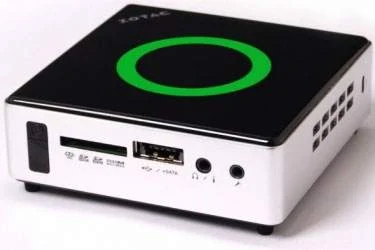Zotac has debuted a $359 uber-mini PC dubbed the ZBOX nano XS AD11 Plus.
The system – which sits in 106-milimeter box that measures only 37-millimeters tall – is powered by an AMD E-450 APU (1.65 GHz, dual-core) with Radeon HD 6320 graphics.

”Size does matter when it comes to desktop systems. We are always trying to push full-featured systems into the smallest size possible,” explained Zotac exec Carsten Berger. “Our new ZBOX shows you can pack a complete HD capable desktop PC into a miniature form factor that conveniently fits in the smallest places.”
According to Berger, the new ZBOX is loaded with a 64GB mSATA SSD, USB 2.0/3.0 ports, a memory stick, Gigabit Ethernet and a USB 802.11n WiFi adapter.
Additional specs include:
* HDMI output
* 2GB DDR3
* Combo eSATA / USB 2.0 port
* 6-in-1 memory card reader (SD/SDHC/SDXC/MMC/MS/MS Pro)
* Combo analogue / mini-Optical S/PDIF output
* Microphone input
* Integrated IR receiver
* Bundled MCE-compatible remote w/USB IR receiver
* Bundled VESA75/100 mount
So how does the new ZBOX stack up against the competition? Well, the system was recently reviewed/benchmarked by Hot Hardware, which termed the ZBOX a “good performer.”
“In comparison to other ultra small form factor systems and similarly equipped mobile devices in its same class, the ZBOX Nano XS AD11 does well. The AMD E-450 APU at the heart of the system is a mild step up from the E-350 APU used in our reference systems and the E-450 had no trouble outpacing any of the Atom-based offerings,” wrote Hot Hardware’s Marco Chiappetta.
“The mSATA SSD included in the ZBOX Nano XS AD11+ model we tested is also a huge step up from the pokey 320GB HD bundled with previous-gen ZBOX Nano systems. The SSD makes the ZBOX Nano XS AD11+ feel much more responsive than previous-gen ZBOX Nanos and we’re glad Zotac decided to go the solid state route with the XS.”
However, Chiappetta did express some concern over the basic USB WiFi adapter which will likely lag while streaming high-bitrate content from a NAS or home server. Other potential issues included problems with the unit’s cooling fan and power button.
“Although the fan on our unit was nearly silent most of the time, on occasion it seemed to go out of balance and sounded like it was churning a bit. The power button on our unit wasn’t always responsive either. We sometimes had to hit it multiple times to get the unit to power up… [Yet], we suspect these problems are isolated, and have another unit on the way. Once we test the new unit, we’ll update this conclusion with our final recommendation,” he added.






